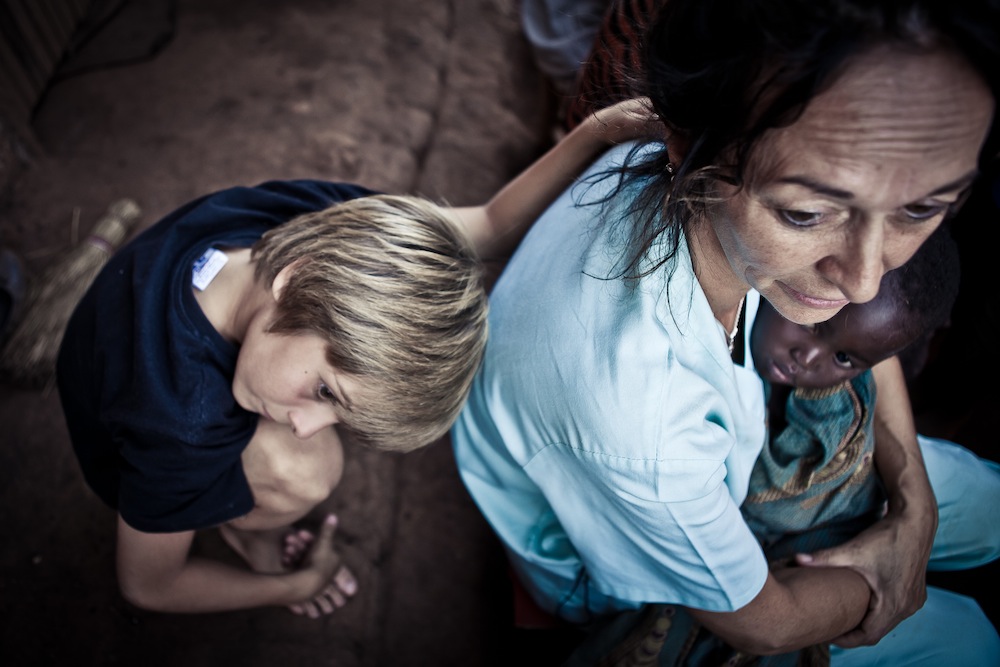PWI -
Paolo, you told us about an English midwife in Malawi, who is doing a fantastic job to help local women and care for them during their pregnancy; please tell us more about this story and how you got involved in this experience
Rachel MacLeod is an English midwife I met in Malawi in 2011 while I was in the country working for an Italian NGO. I’ve seen her working in the maternity ward, that’s why I decided to tell her story using my pictures.
She told me her story: she practiced for nearly 14 years in Spain before moving to Malawi; where she’s worked since 2008 as a clinical midwife in the labor ward of the Bwaila Hospital, in the capital Lilongwe.
Because of her capabilities and experience Rachel is a point of reference for all the other midwives, especially the youngest ones, she is a daily trainer, through her actions constantly teaching and motivating the other midwives, ensuring that all women and their babies are getting the highest possible standard of care.
Rachel works with intensity, energy and enthusiasm facing the emergency situations at Bwaila.
 |
 |
| Rachel with the local hospital team |
Rachel MacLeod with her own child Lucas and a Malawi baby |
PWI – How have you become a humanitarian photographer?
I started traveling in Africa in 2004 and from that day I never stopped. I always travelled with my camera, portraying people I met, places I visited. Coming back home I used to show parents and friends the images I’ve taken, and every time they were so surprised, even shocked, about situations which have become “normal” to me after I have seen them in Africa.
So I realized that probably I could have used my images not only for my personal memories, but to show and share stories with people who have never heard about the problems I have seen.
In the meantime I started traveling with some small non-profit organizations, to visit their aid projects, giving them some of my photographs, in order that they can tell their stories and communicate with their supporters and donors about their projects and activities.
In that moment I decided to become a humanitarian photographer, focused on humanitarian issues and social-documentary, working with NGOs, Aid and Non-Profit Organizations, to create evocative and compelling images which could promote action and change for the sake of the most vulnerable people in the world.
PWI - What are your plans for the future, Paolo?
I will continue working with NGOs, Aid and Non-Profit Organizations about their projects.
I will also continue working; whenever possible, on my personal project for safe pregnancy in Africa.
Every year, just in Sub-Saharan Africa 280.000 mothers die from complications of pregnancy and childbirth; and for every woman who dies, many others suffer injury, infection or disability.
Every year 1,5 million African children are left without a mother.
A mother's death is a human tragedy, affecting families and communities. Her death endangers the lives of a surviving newborn and any other young children; a mother's death makes it harder for the family to obtain life's necessities and escape the crush of poverty.
A great many of these deaths are preventable, when women have access to quality health care services, diagnostic, and treatment services. Most maternal death and morbidity can be prevented when pregnancy and childbirth are attended by skilled health professionals (nurses, midwives or doctors, but women in poor and remote communities are far from the health services. Moreover, reproductive health issues affect most of all young women and girls: in many communities girls still marry when very young and contraceptive advice is poor or non-existent.
"Birth is a dream" I named my photography project about maternity in Africa.
What is a mothers dream? How far away for African mothers is the dream of a safe birth?
Photography is a great and strong way of communication and change: through images I wish to raise awareness about maternity in Africa.
PWI – For our readership would you like to share a couple of little secrets? What are the ingredients and the features that make a picture "unforgettable"?
What I learnt through experience. To get a good picture I can summarize in two main pieces of advice: first, look at images, photographs of other people, not necessarily professional photographers, because you can get a lot of inspiration for your news photos.
Second, and I consider it the real secret to make an unforgettable picture, is to get “close” to the subject you want to portray. “Close” from both the physical and emotional point of view. If you are able to build a relationship with the subject, to approach it with respect and humanity, you will be able to portray the real essence of the mood, atmosphere, feelings you are looking at with your camera.
And now, Paolo, show us the magic of your pictures, a gallery dedicated to PWI Magazine readers!
Click Here
| Short Biography |
Paolo Patruno is a photographer focusing on humanitarian issues and social-documentary, working with NGOs, Aid and Non-Profit Organizations, creating evocative and compelling images which promote action and change for the sake of the most vulnerable people in the world.
He is interested in documenting global topics, including health care, education, human rights, sustainable development and poverty.
His special interaction with people, his understanding of their living conditions, is his key to tell and portray stories, because it allows him to approach people and situations with respect and humanity.
He is working on his personal long term project about Maternity in Africa.
|
|
Contact:
|
.png)
.png)